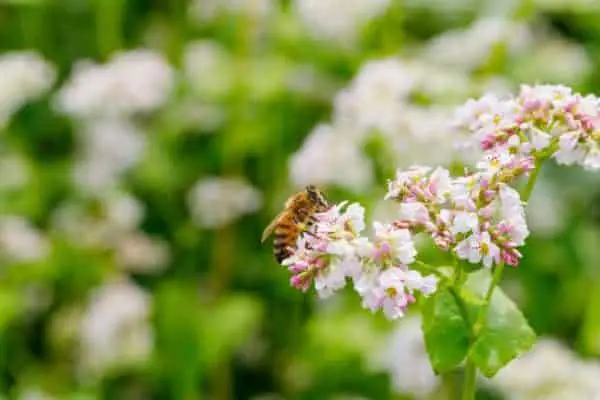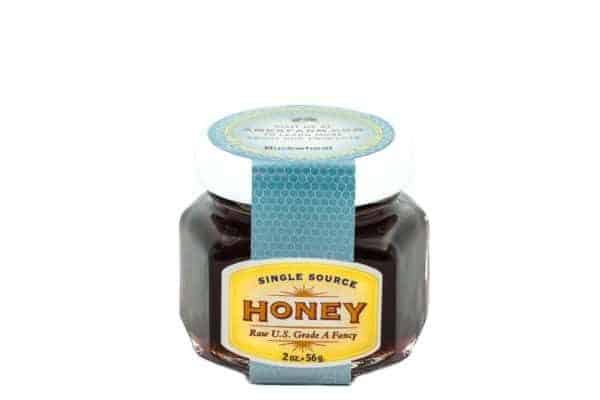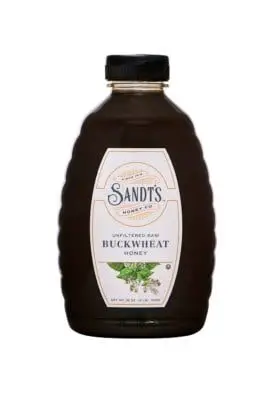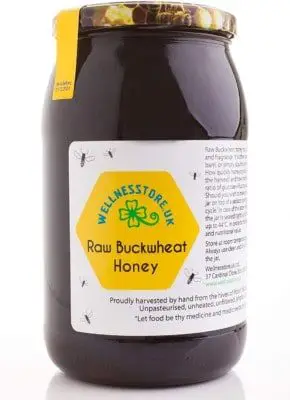What is it about buckwheat honey that makes it so unique and where are you most likely to get it from? If that’s a question that’s been on your mind for a while or one that just popped up as soon as you clicked on this article, you can be certain that you’ll find the answers you need right here.

This variety of honey is made from the flowers of the buckwheat plant. It ranges from rich amber to deep brown in color and possesses a distinct flavor. It is also remarkably nutritious and has been lauded for its exceptionally high antioxidant and vitamin content.
Below we have provided a glimpse of this rather special nectar and all you can expect to discover about it in this post.
Buckwheat Honey: Its Source and Characteristics
Buckwheat, the crop from which this variety of honey is produced, is considered to be a cousin to rhubarb and sorrel and was probably first cultivated by the Chinese about 5,000 years ago.
Considered to be neither a cereal nor a grass, buckwheat is frequently referred to as a pseudocereal. It is also renowned for its ability to produce a harvest in a matter of 10 to 12 weeks, and the nutritional profile of its seeds which are high in protein, carbohydrates, and vitamins.
But as can be seen, we are by no means the only species interested in it: bees are also rather fond of the nectar produced by its abundant white and pink blooms. However, the tiny size of the flowers, means that honeybees need to put in a bit more effort than usual to gather their nectar.
The result is a unique variety of honey that bears a close resemblance to molasses and is jam-packed with antioxidants, minerals, and vitamins.
Its deep brown hue is a key indicator of just how nutritious this ambrosia is. Darker varieties of honey are known to contain less moisture and a higher concentration of vitamins and minerals compared to those which are lighter in color, and buckwheat honey is probably one of the darkest varieties available.
It also possesses a highly impressive antioxidant and ascorbic acid (vitamin C) content which is comparable to that other veritable treasure chest of antioxidants, the tomato.
Buckwheat honey has also proven to be an ideal, natural alternative to manufactured cough syrups for young children over the age of one (honey is considered unsuitable for children under the age of 12 months due to botulism spores which may be present in it).
What’s more, it is also thoroughly efficient at providing antibacterial protection, reducing inflammation and healing injuries, all of which enable it to rank pretty high on the list of truly marvelous natural remedies.
But its source and its nutritional content are far from all there is to buckwheat honey. Like other available varieties, its qualities depend on an additional number of features such as the components of the sugars it consists of. There is also the issue of its availability from season to season, and the regions in which it is produced.
In this article, we shall be taking a look at all these key features and some of the factors which influence them. We shall also be providing some of the best vendors you can purchase it from.
What Does Buckwheat Honey Taste Like?
In terms of flavor, buckwheat honey packs a potent punch that is every bit as unforgettable as its bold dark hue.
Earthy and intense, it also has a characteristic slight bitterness to it which enhances its complexity.
Considered to be of average sweetness, buckwheat honey also possesses malty and spicy notes which further contribute to its distinctive profile.
What Are The Benefits Of Buckwheat Honey?
The nutritional content of buckwheat honey has earned it comparisons to manuka honey another highly popular variety of honey which is also renowned for its health-boosting properties.
Buckwheat honey significantly surpasses manuka in the level of phenols it contains and is just as effective at combating bacterial infections as the latter. It also surpasses manuka honey in its ability to provide general antioxidant protection (the exceptionally high levels of vitamin C it contains also play a key role in this regard).
In addition to its impressive phenol and antioxidant content, buckwheat honey is also rich in iron, manganese, and zinc. These minerals play a key role in enabling our bodies to heal injuries and maintain bone health.
Where Can I Buy Buckwheat Honey And How Much Does It Typically Cost?
Now you are aware of all the wondrous qualities buckwheat honey possesses, you’re most likely thinking that such a mini-marvel deserves pride of place in your kitchen cupboard.
And to aid you in your quest, we’ve listed a few purveyors of the richly-hued elixir who are renowned for providing nothing but the very best to the delight of a thoroughly satisfied customer base.
These include the following:
- Ames Farm: A specialist in single-source honey, Ames Farm has earned national recognition for its high-quality natural products. Its Buckwheat Honey also comes with all you need to know about it, including its location, hive number, and floral source, just like every other variety offered by the retailer.
- Hucklebee Farms: Founded by expert beekeeper, Jim Douglas with the aim of “giving your taste buds a treat”, the outlet also provides a range of flavor-infused offerings and its very own Buckwheat Honey.
- Sandt’s Honey: A family owned outfit that operates from Amazon, Sandt’s has been in the business of providing nature’s rich ambrosia since 1918. Their Sandt’s Buckwheat Honey is raw, non-GMO and unfiltered to preserve its natural goodness.
- Wellness Store: A UK-based brand that also operates from Amazon, this retailer provides several varieties of honey including Eco Raw Buckwheat Honey which is 1.25 kg of raw, unpasteurized, unfiltered nectar from bees that have been fed a sugar-free diet.
Looking for more different and interesting honey varieties? We have done a ton of research for you. If you are interested the article is called, Honey Varieties You Should Discover.
In What Locations Is Buckwheat Honey Produced?
Buckwheat tends to thrive in China and Russia (which are currently its largest producers). Other countries in which it is grown include Brazil, France, Poland and Ukraine.
Out of all these countries, France, Poland, Russia and Ukraine are known to produce buckwheat honey. It is also produced in Finland and Lithuania.
The dark malty honey is also commonly produced in Asian countries such as Bhutan, Japan and Korea.
In the United States, buckwheat honey is produced in regions such as Dakota (both southern and northern states), Montana, New York, Ohio, Pennsylvania, and Wisconsin.
Is Buckwheat Honey Seasonal Or Available All Year Round?
The buckwheat plant from which bees make this dark brown ambrosia happens to produce flowers for a rather extensive period — several weeks in fact (another reason it happens to be a firm favorite of beekeepers, in addition to the quality of its honey).
However, it is mostly a warm season plant which thrives in early summer and does even better later during the season, when it will actually mature more quickly.
Bees too tend to have an itinerary which varies depending on the seasons of the year. Spring, which is the period when several nectar producing flowers tend to blossom in all their glory, is often their busiest season.
They also remain pretty active in summer too, but begin to wind down as colder weather sets in. As winter’s chill draws closer, they will venture out less frequently and opt to remain warm and snug in the hive. And once the frost arrives, they will stay in and tuck into their reserves of food until it’s warm enough to venture outside once more.
In light of these key factors, fresh supplies of buckwheat honey are likely to be at their most abundant during summertime meaning it is seasonal as opposed to being produced all year long.
Does Buckwheat Honey Crystalize In Winter?
The main factors which influence crystallization in any variety of honey include the presence of solids, the proportion of glucose and fructose it contains, and ambient temperature.
Buckwheat honey contains high levels of glucose compared to fructose. The former is less resistant to crystallization than the latter. Hence, glucose tends to form crystals around solids such as pollen present in the honey, which subsequently spread until the entire jar is one semisolid mass of natural sweetness.
It is also worth noting that lower temperatures also encourage the process of crystallization.
So will your buckwheat honey crystallize during winter? It’s highly likely it will. But the process can be undone by simply placing the container in warm water and waiting for its contents to loosen up once more and return to a syrupy state.
An Intensely Flavored Nectar
It comes from an ancient crop which is actually a pseudograin and sports a recognizably dark hue and a distinct malty taste. This summery treat is also capable of rivaling tomatoes in the antioxidant and ascorbic acid stakes making it a superfood of sorts. What’s more, it’s actually capable of trumping cough syrups in its ability to soothe little children and ease their symptoms.
People all over the world can get to enjoy its goodness but it’s mostly produced in Eastern Europe, France and the United States.
Because the crop responsible for its production loves a bit of warm weather, the purple-hued ambrosia is most likely to be produced during summer.
It’s also highly prone to crystallization, although that’s nothing that a brief immersion in a bowl of warm water won’t fix.
This then is the marvel that’s buckwheat honey and you too can experience it’s complex flavour map, healing and medicinal properties for yourself.
Maybe you’re like us and enjoy tasting honey from different origins and regions or maybe you’re just realizing that there is more to honey than what you see on the supermarket shelves.
We have done the research for you on a whole range of varieties of honey for you. Below is a list of different types of honey from different floral origins and regions. If you are interested check them out, Honey Varieties You Should Discover.



